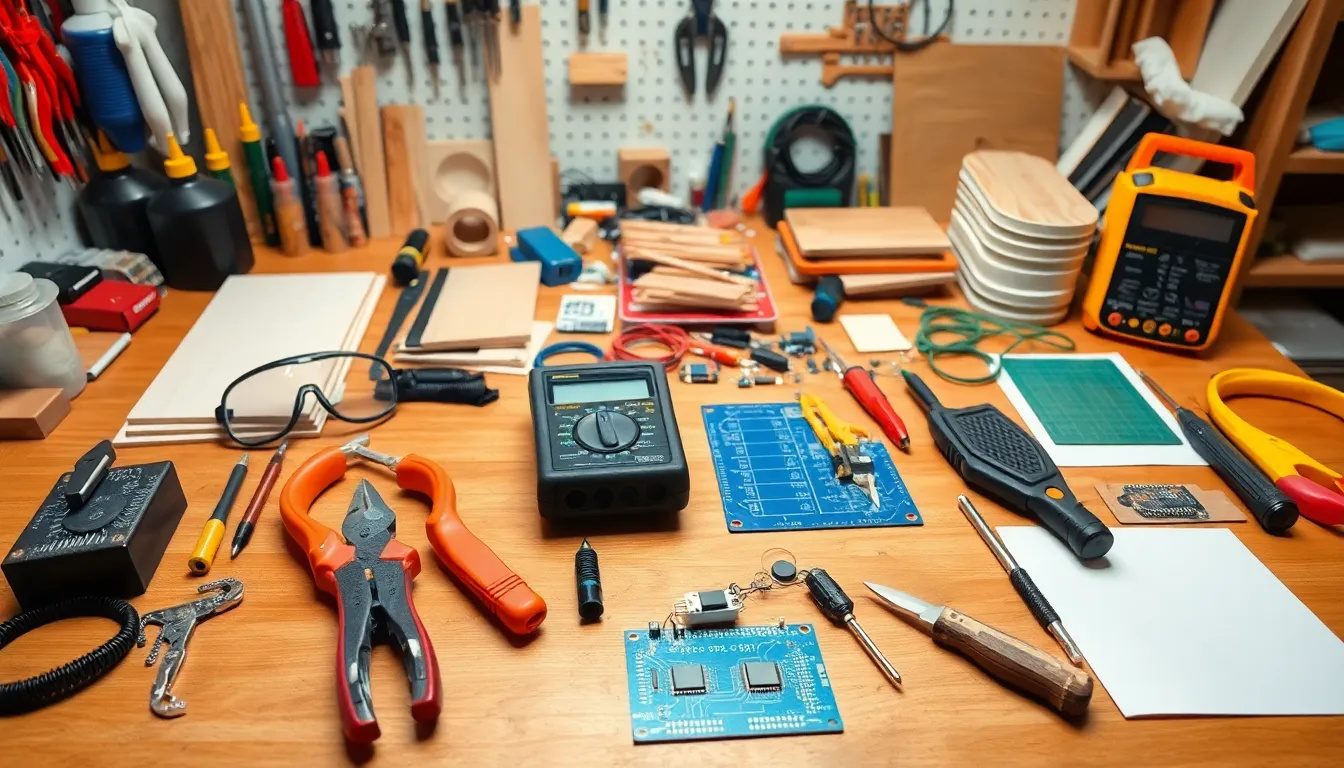Table of Contents
ToggleIn a world where store-bought solutions often fall short, DIY engineering projects offer a thrilling escape into creativity and innovation. Imagine transforming mundane materials into extraordinary inventions right in your garage or living room. Whether it’s building a robot that fetches your snacks or creating a solar-powered phone charger, the possibilities are endless—and let’s be honest, who wouldn’t want to impress their friends with a homemade gadget?
Overview Of DIY Engineering Projects
DIY engineering projects offer an engaging way to create unique inventions using everyday materials. The opportunity to innovate fuels creativity and provides a sense of accomplishment.
Benefits Of DIY Engineering Projects
DIY engineering projects enhance problem-solving skills. Individuals learn to tackle challenges through hands-on experience. These projects foster critical thinking, encouraging innovative approaches to design. Working on DIY projects also promotes collaboration when done in groups, strengthening communication skills and teamwork. Passion and satisfaction unite as creators build something functional from scratch. Additionally, cost savings emerge compared to store-bought alternatives, making it an attractive option for budget-conscious makers.
Popular Types Of Projects
Several popular types of DIY engineering projects capture interest. Robotics stands out as a favorite, with designs ranging from simple automated toys to advanced humanoid robots. Another prevalent category includes renewable energy projects, such as solar-powered chargers or wind turbines. Circuit design projects attract tech enthusiasts, allowing for custom creations like audio amplifiers or smart home devices. Creative woodworking projects incorporate engineering principles to craft functional furniture or innovative storage solutions. Individuals gravitate toward these types, resulting in a diverse community of makers.
Essential Tools And Materials

Successful DIY engineering projects rely on the right tools and materials. Having these essentials on hand simplifies the process and enhances creativity.
Basic Tools For DIY Engineering
Commonly used tools include screwdrivers, pliers, and wrenches. A soldering iron plays a crucial role in connecting electronic components. Additionally, a multimeter enables users to measure voltage, current, and resistance accurately. Consider a laser cutter for precise cuts in various materials. Safety goggles protect the eyes during construction, while a utility knife proves invaluable for making clean cuts.
Recommended Materials
Selecting the right materials is vital for project success. Wood, plastic, and metal serve as popular bases for construction. Circuit boards and various sensors play integral roles in electronics projects. Furthermore, consider using motors and batteries for mechanical movements in designs. Solar panels provide an eco-friendly energy source when building renewable energy projects. Lastly, glue and screws secure components, ensuring structural integrity.
Project Ideas For Beginners
DIY engineering projects offer a range of possibilities for beginners. The following ideas introduce foundational concepts in mechanical and electronics engineering.
Simple Mechanical Projects
Building a catapult provides hands-on experience with lever mechanics. Create a rubber band-powered vehicle using simple materials like plastic bottles, wheels, and axles. Constructing a wind vane helps understand wind direction while incorporating materials like cardboard and straws. Designing a simple bridge with popsicle sticks tests structural integrity and design efficiency. These projects encourage creativity and problem-solving skills, making engineering concepts tangible and accessible.
Basic Electronics Projects
Begin with a simple LED circuit to learn about basic circuit design. Use a breadboard for easy arrangement of components such as resistors, batteries, and LEDs. Construct a light-sensitive switch with a photoresistor, which introduces concepts of light detection and automated systems. Build a basic alarm system using a buzzer and motion sensor to explore security systems. These projects foster an understanding of electronics and inspire advanced designs as skills develop.
Intermediate DIY Engineering Projects
Intermediate DIY engineering projects challenge skills while providing opportunities for creativity and innovation. These projects elevate the engineering experience through complex concepts in robotics and home automation.
Robotics Projects
Robotics projects engage critical thinking and technical skills. Building a simple robot car illustrates navigation and movement concepts. Creating a robotic arm enhances understanding of grip mechanics and automation. Programmable robots, such as Arduino-based kits, introduce coding and electronics. Students can modify sensors for improved interaction with the environment. These projects foster problem-solving and can be collaborative, making them perfect for groups or classrooms.
Home Automation Ideas
Home automation projects offer practical solutions that enhance daily life. Creating a smart lighting system enables control through mobile devices or voice commands. Designing a temperature-regulated environment helps you understand thermoregulation and energy efficiency. Integrating sensors with home systems provides real-time data and alerts, improving safety and convenience. Utilizing platforms like Raspberry Pi or Arduino connects various elements, allowing customization and scalability. These projects encourage innovation while simplifying home management.
Advanced DIY Engineering Projects
Advanced DIY engineering projects push boundaries and stimulate innovation. They give enthusiasts the chance to delve deeper into engineering concepts and technologies.
Advanced Robotics and AI Projects
Robotics projects provide opportunities to explore artificial intelligence applications. Building a drone involves integrating sensors and camera systems to enable autonomous navigation. Programmable robotic arms can perform tasks with precision, using coding platforms like Arduino or Raspberry Pi. Enhancing these robots with machine learning algorithms fosters a deeper understanding of adaptive technologies. Participants can also experiment with swarm robotics, where multiple robots communicate and coordinate their actions, mimicking nature’s efficiencies. These projects develop critical thinking and technical skills while promoting collaboration among creators.
Innovative Renewable Energy Projects
Renewable energy projects emphasize sustainability and environmental responsibility. Constructing a solar-powered water heater showcases principles of thermodynamics and energy transfer. Wind turbine projects allow builders to harness wind energy, demonstrating effective design and efficiency maximization. Participants can create biogas digesters, converting organic waste into usable energy. Experimenting with energy storage solutions, such as homemade batteries, enhances knowledge about energy conservation and management. Engaging in these projects encourages creativity while addressing real-world energy challenges.
DIY engineering projects offer an exciting avenue for creativity and innovation. They empower individuals to transform everyday materials into unique inventions while enhancing critical skills. The sense of accomplishment and cost savings further solidify the appeal of these projects.
Whether tackling beginner, intermediate, or advanced challenges, there’s something for everyone in the DIY community. The right tools and materials play a crucial role in ensuring success. As enthusiasts explore robotics, renewable energy, and creative woodworking, they not only develop technical skills but also foster collaboration and problem-solving abilities.
Ultimately, engaging in DIY engineering projects can lead to a fulfilling journey of discovery and innovation, inspiring the next generation of makers and thinkers.




